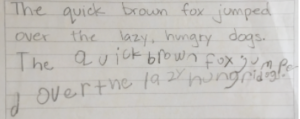Dysgraphia
By: Morgan Kimball
What is Dysgraphia?
Dysgraphia is a neurological disorder characterized by writing struggles. Specifically, it causes a person’s writing to be distorted or incorrect. The word Dysgraphia is a Greek word. The prefix dys indicates that there is impairment. Graph refers to producing letter form by hand, and the suffix ia refers to having a condition. Therefore, Dysgraphia means there is a condition of impaired letter writing by hand.
Is Dysgraphia a Form of Dyslexia?
Dyslexia and dysgraphia are two different neurological conditions. Dyslexia is a learning difference that makes it hard for an individual to learn how to read and struggle to break down words into sounds or relate letters to sounds when reading. Where dysgraphia involves difficulty with the act of writing, it can range from issues with physically writing words to issues with organizing and expressing thoughts in written form.
Students may have issues with the following:
- Letter formation and/or legibility
- Letter size and spacing
- Spelling
- Fine motor skills
- Rate or speed of writing
- Grammar and punctuation
Here are some specific ways dysgraphia can be presented:
- Difficulties writing in a straight line
- Difficulties holding and controlling a writing tool
- Writing letters in reverse
- Having trouble recalling how letters are formed
- Having trouble knowing when to use a lower or upper case letter
- Struggling to form written sentences with correct grammar and punctuation
- Omitting words from sentences
- Incorrectly ordering words in sentences
- Using verbs and pronouns incorrectly
Testing for Dysgraphia
Just like dyslexia, getting your child tested early for dysgraphia is best for learning differences. Your child can learn new writing strategies sooner when dysgraphia is dedicated early. There is no medical testing required for dysgraphia. A healthcare provider and education specialists can assess your child’s writing struggles to make a diagnosis. Here are some assessments and tests that can be used:
- Formlized handwriting assessments: These tests can help measure the speed and legibility of your child’s writing.
- Beery Developmental Test of Visuomotor Integration (VMI): This test helps assess the extent to which a child can integrate their visual and motor skills, which is necessary for writing.


